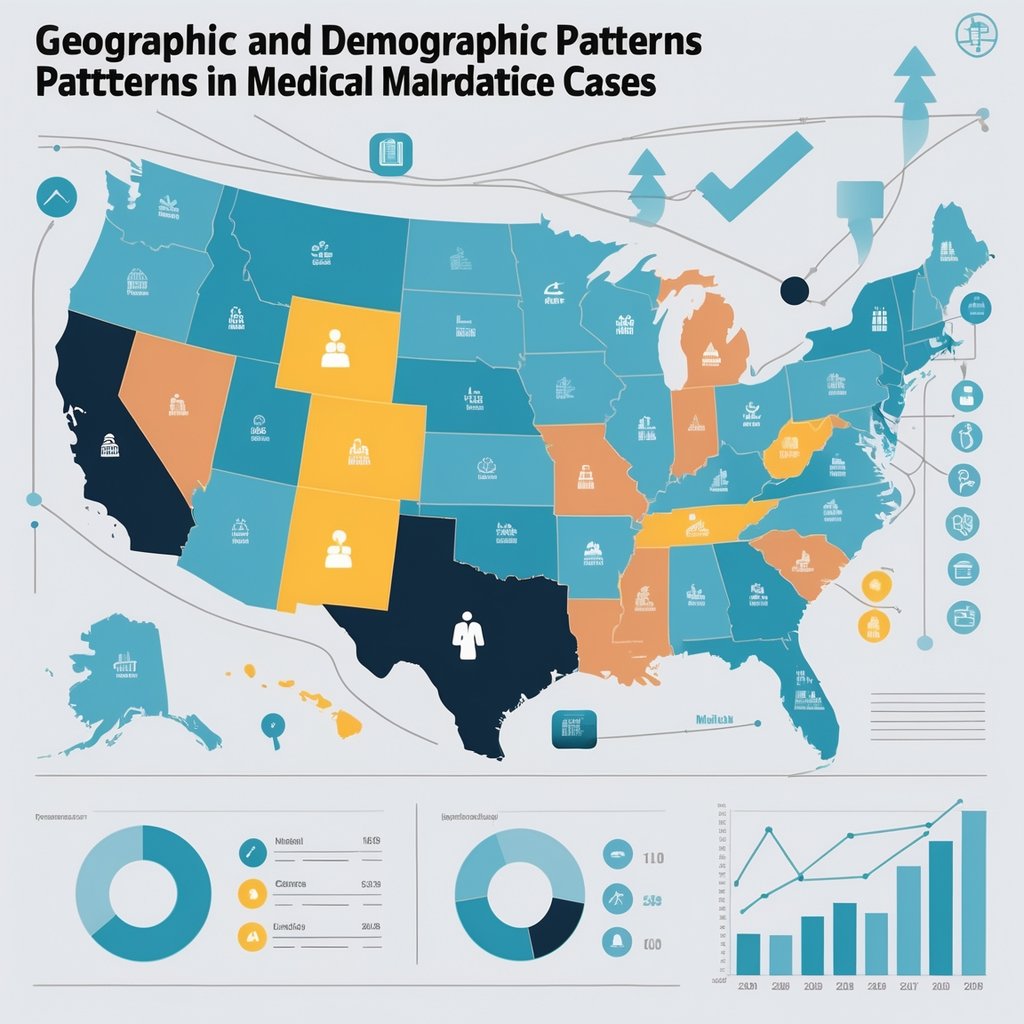Medical errors happen more often than most people think. Thousands of patients across the United States feel the impact every year.
If you’ve ever wondered about the scope of medical malpractice in America, the numbers might surprise you.

The United States sees approximately 85,000 medical malpractice cases filed each year. Other sources say an average of 20,000 cases per year actually make it to court.
These numbers show the gap between potential cases and those that become formal lawsuits.
Medical malpractice affects people from all backgrounds. Some groups face higher risks than others.
Key Takeaways
- Medical malpractice cases filed annually range from 20,000 to 85,000 depending on how they’re counted
- Medical errors cause 251,000 deaths each year, making it the third leading cause of death in America
- Over 96% of successful malpractice claims settle out of court rather than going to trial
Annual Volume Of Medical Malpractice Cases

The number of medical malpractice cases filed each year varies a lot depending on where you look. Current statistics show approximately 11,400 medical malpractice cases in 2023.
Historical data points to much higher filing rates.
Recent Case Count And Trends
Recent data shows a noticeable drop in medical malpractice filings compared to the past. The first half of 2024 shows 4,670 reported cases.
Annual totals may stay close to 2023 levels.
This is a big change from earlier years. Between 1990 and 2020, about 1.41 million cases were filed, averaging 47,000 cases per year.
Some sources give different numbers for annual filings. One analysis finds an average of 85,000 cases filed each year, while another study says 20,000 cases per year are filed in the United States.
National Practitioner Data Bank Data
The National Practitioner Data Bank tracks medical malpractice cases and settlements. According to NPDB data, there were an average of 12,414 medical malpractice cases every year from 2009 to 2018.
This database includes both trials and settlements. NPDB stats show more consistent numbers since it tracks actual payouts, not just filings.
Key NPDB findings include:
- Annual case volumes stayed steady during 2009-2018
- Tracks both settlements and verdicts
- Breaks down case frequencies by state
Comparison To Other Personal Injury Cases
Medical malpractice cases make up a small slice of all personal injury lawsuits. Malpractice statistics show that medical malpractice accounts for less than 5% of all personal injury cases pending nationwide.
This low percentage challenges the popular idea that healthcare lawsuits are everywhere. Even with all the talk about excessive litigation, the numbers show medical malpractice claims are still relatively rare compared to other injury cases.
Only about 2% of people who experience medical malpractice ever file claims for compensation. That means actual malpractice incidents probably far outnumber reported cases.
Types Of Medical Malpractice And Common Causes

Most medical malpractice cases fall into a few main categories based on the type of error or negligence. Failure to diagnose makes up 26% of claims, surgical errors 24%, and improper treatment 28.5% of cases.
Misdiagnosis And Failure To Diagnose
Diagnostic failures are one of the most common types of medical negligence. This happens when your healthcare provider doesn’t identify your condition or delays diagnosis too long.
Common diagnostic errors include:
- Missing cancer diagnoses in early stages
- Failing to recognize heart attacks or strokes
- Misidentifying infections as minor illnesses
- Overlooking fractures in X-rays
Missing a diagnosis can cost you valuable treatment time. Your condition might get worse or become untreatable.
Diagnostic failure cases often involve the most serious medical conditions. Sometimes providers skip important tests or misread results.
Emergency room misdiagnosis is a big part of these cases. The fast pace can lead to missed symptoms and rushed decisions.
Surgical Errors
Surgical errors happen when your surgeon or surgical team makes mistakes that could have been prevented. These can occur before, during, or after your operation.
Major types of surgical errors include:
- Wrong-site surgery (operating on the wrong body part)
- Leaving surgical instruments inside your body
- Damaging organs or tissues during surgery
- Performing the wrong procedure
Anesthesia complications during surgery also count here. Your anesthesiologist might give too much or too little medication, causing serious problems.
Sometimes poor surgical planning leads to unnecessary procedures or missed treatment. Your surgeon needs to pick the right approach.
Post-operative care errors can be just as dangerous. If your team doesn’t monitor you after surgery, complications can go unnoticed until it’s too late.
Medication And Prescription Errors
Prescription errors and medication mistakes harm thousands of patients every year. Adverse drug events account for 5.1% of medical malpractice claims.
Common medication errors include:
- Prescribing the wrong medication
- Incorrect dosage amounts
- Missing dangerous drug interactions
- Giving medications to the wrong patient
Pharmacists also play a part in medication errors. They might give out the wrong drug or miss risky combinations.
Hospital medication errors often happen during shift changes. Nurses sometimes miscommunicate, leading to missed or duplicate doses.
Drug allergies are another big concern. If your healthcare team skips your allergy history, you could have a severe reaction.
Anesthesia And Other Medical Errors
Anesthesia errors can cause serious harm or even death during procedures. Anesthesiologists need to calculate dosages carefully and monitor you throughout.
Types of anesthesia errors include:
- Giving too much anesthesia
- Missing drops in oxygen levels
- Equipment failures
- Not evaluating patients before surgery
Birth injuries make up another major group of medical errors. Obstetricians sometimes fail to handle delivery complications, leading to permanent harm.
Emergency rooms often struggle with overcrowding and short staffing. These problems can delay treatment or cause missed diagnoses.
Injection site injuries and improper patient monitoring add to malpractice claims. Providers should follow protocols to prevent these issues.
Medical Malpractice Deaths And Patient Impact

Medical errors cause a shocking amount of harm and death in the US healthcare system. Medical errors result in 250,000 deaths each year, putting it up there with heart disease and cancer.
Annual Deaths Due To Medical Errors
Medical errors kill more people than most expect. Medical malpractice is the third most common cause of death in the United States.
The numbers are staggering. Medical errors cause 251,000 fatalities annually according to Johns Hopkins.
These deaths make up 9.5% of all deaths in the U.S. each year. That puts medical errors ahead of respiratory disease, strokes, and accidents.
Some research hints the real number could be even higher. As many as 440,000 people may die yearly from medical errors since death certificates often miss the true cause.
Most Deadly Types of Medical Errors:
- Misdiagnosis or delayed diagnosis
- Surgical complications
- Medication errors
- Hospital-acquired infections
Long-Term Consequences For Patients
Medical errors that don’t kill can still cause serious harm. Prescription errors harm 1.5 million people annually.
The financial impact is huge. Medical errors cause $3.5 billion in damages from prescription mistakes alone each year.
You might end up with permanent disabilities from medical mistakes. Brain injuries, organ damage, and chronic pain often follow surgical errors.
Long-term effects include:
- Physical disabilities needing long-term care
- Emotional trauma and loss of trust in healthcare
- Financial burden from more medical bills
- Lost income if you can’t work
Recovery can drag on for years or never fully happen. Many patients need extra surgeries to fix what went wrong the first time.
Medical Malpractice Claims, Lawsuits, And Litigation

Medical malpractice litigation is complicated. Most claims settle out of court instead of reaching a jury, and the number of new cases has changed a lot over the years.
Frequency Of Malpractice Claims
About 85,000 medical malpractice cases are filed each year in the United States. This number shifts a lot depending on the state and the year.
Between 1990 and 2020, 1.41 million medical malpractice cases were filed. That averages out to roughly 47,000 cases per year over three decades.
Different organizations track and report these statistics in their own ways. Some count lawsuits filed, others count paid claims or settlements.
Key claim statistics:
- One in three healthcare providers gets sued during their career
- California had the highest number of claims per capita in 2022 with 4,638 reports
- Vermont, Hawaii, Rhode Island, South Dakota, and Idaho had the lowest claim rates
Litigation Rates And Outcomes
Your odds of winning a medical malpractice lawsuit depend on many things. Plaintiffs succeed in about 30% to 40% of cases.
Most cases never reach trial. Roughly 80 to 90% of defensible malpractice claims get dismissed without any payment.
Lawyers usually dig into discovery and negotiate before anyone sees a courtroom.
Outcome breakdown:
- 30-40% success rate for plaintiffs
- 80-90% of defensible claims dismissed
- Most successful claims settle out of court
Trends In Settlement Versus Trial
About 96.9% of successful medical malpractice claims settle out of court. Fewer than 4% of winning cases ever go to trial.
The average settlement was $329,565 between 2009 and 2014. More recent numbers show average payouts of about $309,908 from 2009-2018.
Settlement amounts swing wildly depending on case type. The biggest payouts usually involve unnecessary procedures or failure to treat fetal distress during childbirth.
Insurance data showed a 55% drop in paid malpractice claims from 2009 to 2014.
Medical Malpractice Payouts And Economic Impact

Medical malpractice payouts hit the healthcare system hard. Total payouts reached $3.1 billion in 2021, but settlement amounts and economic burden vary a lot.
Annual Payout Totals
Hospitals and insurers process thousands of malpractice payments every year. In 2021, 9,003 total malpractice cases appeared across all states.
Total annual payouts hit $3.14 billion in 2021. This money goes straight to patients and families after medical negligence.
Case numbers jump around from state to state. Florida had 1,034 cases, but Vermont had only 7.
New York paid out the most—$418 million—even though it had fewer cases than Florida.
Big states see more cases simply because they have more people and hospitals.
Average Settlement Amounts
Your malpractice settlement depends on a handful of things: how bad the injury is, where you live, and what future care will cost. The national average payout was $350,000 per case in 2021.
State averages:
- Highest: Minnesota ($780,000), Maine ($710,000), Iowa ($710,000)
- Lowest: Puerto Rico ($60,000), Texas ($200,000), Idaho ($220,000)
Severe injuries and lifelong care needs push payouts higher. Kids and younger adults with major injuries often see the biggest numbers.
State laws can cap your settlement, no matter how serious the injury.
Financial Burden On The Healthcare System
Medical mistakes cost way more than just the payouts. Insurance, legal fees, and defensive medicine drive up expenses.
Doctors and hospitals in high-payout states pay more for malpractice insurance. That cost trickles down to patients.
Economic burden includes:
- Higher healthcare costs for everyone
- More defensive medicine
- Legal and administrative costs
- Lost productivity from drawn-out lawsuits
An estimated 250,000 Americans die each year from medical errors, but only 1.2% of those cases lead to payouts.
This gap suggests the real cost of negligence is much bigger than the numbers show.
High insurance costs can make providers limit services or move to states with less malpractice risk.
Geographic And Demographic Patterns In Malpractice Cases

Medical malpractice stats bounce all over the place depending on state, specialty, and patient population. Location and physician specialty matter most for claim frequency and payout size.
Cases And Payouts By State
Some states see thousands more malpractice cases than others. Population size and state laws drive these differences.
High-Volume States:
- California
- New York
- Florida
- Texas
- Pennsylvania
These states handle most of the country’s malpractice claims. More people means more opportunities for something to go wrong.
Settlements and verdicts run higher in states with bigger cities and higher living costs.
Legal rules change things too. Some states cap damages or set tight deadlines for filing.
Specialties With Highest Cases
Some specialties just get sued more. OB-GYNs pay almost double for malpractice insurance compared to general docs.
Highest-Risk:
- Obstetrics and Gynecology
- Surgery
- Emergency Medicine
- Radiology
- Anesthesiology
Surgeons and ER doctors deal with high-stakes situations. Mistakes can mean life or death.
Lower-Risk:
- Psychiatry
- Dermatology
- Family Medicine
- Pediatrics
If you see a surgeon, your risk of a medical error is higher than if you see a dermatologist.
Demographic Disparities
Patient age, income, and location all affect the odds of medical errors and your ability to sue for malpractice.
Age:
- Older patients see more errors
- Children face different risks
- Middle-aged adults file the most lawsuits
Older folks often have more health problems, which makes mistakes more likely.
Economic Barriers:
Low-income patients struggle to afford legal help. Lawyers usually want cases with big damages.
Rural patients have it even tougher. Fewer doctors and longer drives mean delays and missed diagnoses.
Recent Trends And Future Outlook

Malpractice case numbers bounce between increases and declines, depending on where you look. Laws keep changing, which makes the landscape even messier.
Decline Or Increase In Cases
Some data says malpractice claims are rising. Healthcare providers feel the pressure.
Other sources point to a drop. An insurance report from 2017 found a 55% decrease in paid claims from 2009 to 2014.
About 11,400 malpractice cases showed up in 2023. The first half of 2024 already saw 4,670 reported cases.
Trends:
- Larger settlements pop up more often
- High-value verdicts happen more frequently
- Severity of claims keeps climbing
- People demand bigger compensation
Payouts have grown a lot. Total malpractice payments jumped from $2.5 billion in 1991 to $4.15 billion in 2023.
Impact Of Legislation And Reforms
Malpractice laws differ wildly between states. Some limit damages, others don’t.
Pennsylvania and New Jersey don’t cap non-economic damages. Pennsylvania only limits future medical care plans.
California is strict. The state caps non-economic malpractice damages at $350,000. Wrongful death bumps the cap to $500,000.
Documentation matters more than ever. About 20% of malpractice cases involve at least one documentation error.
If your case has documentation problems, the odds of a payout more than double.
States keep tweaking malpractice laws, trying to balance patient rights with protecting doctors.
Frequently Asked Questions
About 20,000 medical malpractice cases get filed each year in the US. Only about 2% of doctors get sued each year.
What is the average success rate of medical malpractice cases?
Most payouts happen through settlements, not court verdicts. Over 96% of total malpractice payouts come from settlements.
Success rates depend on how you define success. If you only count cases that end with money changing hands, the percentage is lower than the number of cases filed.
A lot of cases get dismissed or dropped before any money is paid.
How have medical malpractice case numbers changed over the past five years?
Malpractice cases have dipped a bit in recent years. From 2019 to 2023, over 53,000 malpractice claims led to payouts.
2023 alone saw 11,248 cases and over $4.67 billion in payouts. The first half of 2024 already has 4,670 reported cases.
Case numbers dropped in 2020-21 during the Covid pandemic. The overall downward trend might also come from tougher regulations and more hoops to jump through just to file a claim.
What are the most current statistics on medical malpractice in the United States?
The latest data from 2023 reports approximately 11,400 medical malpractice cases in the U.S. Total payouts topped $4.67 billion for that year.
About 44% of successful medical malpractice claims involved negligence during inpatient stays. Another 42% happened with outpatients. The rest took place in other types of healthcare settings.
Diagnostic errors cause nearly a third of all successful claims. Surgical mistakes make up 23% of cases, and birth injuries or obstetrics follow at 12%.
Can medical malpractice statistics be broken down by individual states?
Medical malpractice data shifts a lot from state to state. New York leads with 14,424 successful cases over the last decade. Florida follows with 11,353, and California comes in at 11,262.
New York also racks up the highest total payouts at $6.33 billion. Pennsylvania comes next at $3.36 billion. These five top states account for 43% of payouts, though they represent just 28% of successful cases.
North Dakota sits at the bottom with only 88 cases over the decade. Vermont has 140, and Wyoming 142. State laws and population size really shape these numbers.
What statistical trends are observed in medical malpractice cases globally?
Global medical malpractice stats are tricky. Countries use different legal systems, reporting rules, and healthcare setups.
Many places with socialized healthcare show different patterns than the U.S. Some countries rely on specialized medical courts or administrative compensation rather than lawsuits.
International comparisons get messy. Definitions of malpractice and reporting standards just aren’t the same everywhere. The U.S. seems to have more detailed tracking, thanks to the National Practitioner Data Bank.
How frequently does an average physician face malpractice lawsuits?
Only about 2% of doctors are sued for medical malpractice annually. These doctors might make up as much as 66% of malpractice claims, so a handful of physicians deal with lawsuits more than once.
Specialty really plays a role in how often lawsuits happen. Surgeons, obstetricians, and emergency medicine doctors tend to get sued more often than family practitioners or psychiatrists.
Most physicians will deal with at least one malpractice claim in their career. The odds go up as they spend more years practicing and take on riskier procedures.











